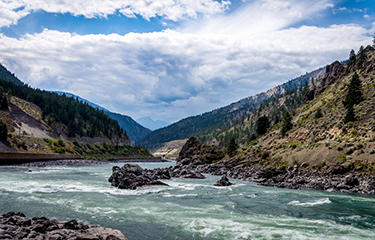Fraser River chinook stocks will continue to be controlled by management measures put into place in 2019, and additional measures are being introduced to support lower fish mortality rates, Fisheries and Oceans Canada announced during a teleconference briefing on Friday, 19 June.
Specifically, a maximum size limit of 80 centimeters in southern marine recreational fisheries will be enforced for July and August, as well as a fishing closure at the mouth of the Fraser River will also be imposed.
Limited harvest for First Nations will be allowed, and the commercial troll fishery will be pushed back into August, intended to avoid Fraser chinook encounters.
“This is a species that is declining throughout their range from California all the way up to Alaska,” said Sue Grant, head of Canada’s State of Salmon program. “In the Fraser watershed, many of these populations are facing an imminent threat of extinction.”
In November 2018, the Committee on the Status of Endangered Wildlife in Canada determined 12 of the 13 Fraser River chinook stocks to be at risk.
Regional Director of Fisheries Management Andrew Thompson announced that measures put in place for 2020 will be implemented in a way that still allows for some social, ceremonial, recreational, and commercial harvest of the fish, but also respects the need to put in place restrictions and protect the Fraser River stocks that are in the most critical condition.
Grant spoke at length about the role that climate change is having on Fraser River stocks. She pointed out that in Canada, the rates of global warming are double the average globally because northern parts of the earth are warming at a faster rate that the rest of the planet.
“Not only are air temperatures warming, but we are also seeing anomalously low snowcaps early in the season. A combination of those warmer air temperatures and lower snowpacks is increasing our river temperatures,” she said.
Grant noted that in recent summers the rivers have been measured in the upper thermal limits for salmon – in the 19 to 20 degree Celsius range. This, in turn, increases stress on the stocks and decreases the number of fish that successfully make it to their spawning grounds. Those that are able to spawn produce weak offspring due to stress incurred during the migratory route.
On top of warming air and water temperatures, Grant also pointed out that climate change is leading to more extreme precipitation events – which in combination with deforestation and record forest fire years, can lead to landslides like the one seen near Big Bar. That landslide continues to impact the migration of salmon on the Fraser River, more than a year after the landslide occurred in June 2019, with multiple efforts – including a “salmon cannon” – being employed to help salmon overcome the landslide.
Grant also referenced “The Blob,” the marine heatwave which increased Northern Pacific Ocean temperatures 3.5 degrees Celsius above the average. That had an impact on the prey consumed by Fraser River stocks, causing nutritious zooplankton eaten by salmon in the marine environment to be less abundant. She added Fraser River salmon tend to return to the river at smaller sizes, younger ages, and with fewer eggs produced per female.
Regional Salmon Resource Manager Jeff Grout said that the approach in place for Spring 4-2, Spring 5-2, and Summer 5-2 (management units) chinook which are currently returning to the river is intended to be precautionary and to avoid impact on the stocks.
He reported that the Summer 4-1 run is healthy enough to support fisheries, although he cautioned that “we need to do that in a way that doesn’t seriously negatively impact our conservation objectives.”
“Our measures are intended to provide a high degree of protection to these chinook,” he said, adding that First Nations and other stakeholders were extensively consulted by the department when management decisions were being made.
Marine Mammal Advisor Kendra Moore also spoke about steps taken intended protect the southern resident killer whales, for which chinook salmon serve as the preferred prey. A now-rejected lawsuit filed earlier this year sought the closure of the Chinook salmon season in Alaska to protect the species.
Fishing closures in the Strait of Juan De Fuca and the Gulf Islands will be observed over the summer and in some locations until the end of November. The “Be Whale Wise” guidelines proposed by the government ask fishermen to stop fishing within 1,000 meters of killer whales, limit the use of echo sounders, and slow boat speed.
Photo courtesy of Harry Beugelink/Shutterstock






